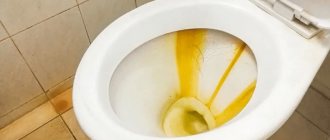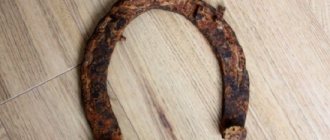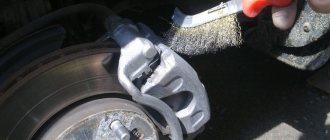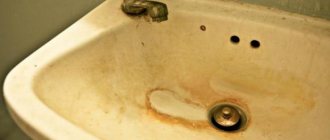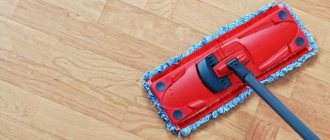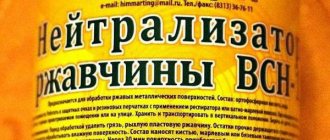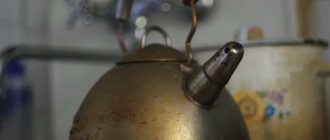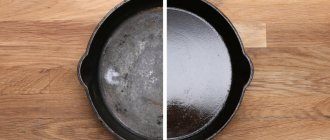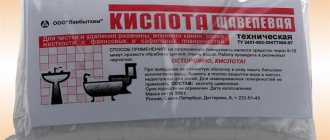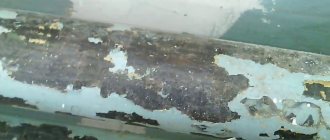Nitric acid
A weakly concentrated 58% solution can be purchased without any permitting documents in departments selling chemicals.
You can remove rust with nitric acid in a matter of minutes. For metal processing it is diluted to 10%. But acid can also poison the metal itself. Therefore, carrying out such experiments requires some experience.
The concentration of the solution intended to remove rust will need to be accurately calculated depending on the amount of metal. You will also need to monitor the process: as soon as the acid reacts with the oxide, the process of metal decomposition may begin. Plus, when working with such solutions, you need a high-quality exhaust hood and strict adherence to safety precautions.
Since acid can corrode not only rust, but also metal, this method is not suitable for processing metal-cutting tools (for example, dies, taps). The thread diameter can change significantly. Acids are especially dangerous for carbon steels. The more carbon they contain, the more damaged the metal will be.
Harm from rust or why you need to fight it
Everyone knows the danger of corrosion. In addition to the fact that the appearance of the metal part deteriorates, it also begins to lose its mechanical properties - strength, elasticity, rigidity, etc. Many people do not pay attention to the appearance of rust spots, which increase in size over time. The main danger of corrosion is that it corrodes the metal inside, making it ultimately unusable. As a result, you have to buy new parts, which causes additional costs.
The reasons for the need to combat rust are known. This must be done not only to protect the part from complete unsuitability, but also for aesthetic purposes. Moreover, the process of combating corrosion must be approached responsibly. An incorrect approach will only accelerate the rusting process, and in a short period of time it will fail.
Hydrochloric acid
It acts as quickly as nitrogen. The metal begins to turn white literally before our eyes. Since the reaction process produces hazardous gases, you should not get too close to the container in which the treatment is being carried out.
A slower, but also safest method of cleaning is to mix the acid with flour. Its addition will significantly reduce the rate of metal etching. However, it will take more time to remove the rust. You can also try adding methenamine, which is a corrosion inhibitor (suppressant), to the hodgepodge.
When processing any of the acids to neutralize its residues, the product must be washed in ammonia or a weak alkaline solution of soda or soap. Please note that after removing the oily film, the metal product can literally turn red again within half an hour. Therefore, after cleaning with an anti-rust agent, it must be immediately wiped dry or thoroughly calcined so that the water completely evaporates.
The part is then lubricated, coated with a layer of zinc or painted. If it is not possible to treat the metal with an anti-corrosion compound in the near future, it is coated with a spray bottle with a mixture of lithol (solidol) and gasoline.
Alternative cleaning options
In addition to the effects of acids, rust can be eliminated using special purchased products and home recipes.
Home Recipes
The simplest options include:
Aluminum foil , which can be found in the kitchen. If you make a lump out of it and rub it over the area of corrosion, the damage will be eliminated.- Baking soda . Removes rust well. Before application, it is diluted with water to a paste, applied to the surface for half an hour, and then cleaned off.
- Hydrogen peroxide . It is suitable for removing rusty stains from plumbing fixtures and tiles.
Home remedies are recommended for minor corrosion damage, as most are less effective than store-bought medications.
Purchased funds
Special preparations for removing rust from metal surfaces can be either acid-containing or acid-free. In addition to active ingredients, the preparations contain thickeners, inhibitors and other substances.
Well-proven means include the following:
- Sonax;
- Chain mail;
- Hairdryer;
- Hi-Gear Rust Treatment and others.
You should use purchased products only according to the instructions, taking all precautions.
Phosphoric acid
This method is perhaps the most common and safest. After all, phosphoric acid does not remove the oxide layer, but turns it into a film that can serve as an anti-corrosion coating. However, this method is only suitable for metal products that are only slightly affected by rust.
There is a special product on sale called “Anti-rust”. It is made precisely on the basis of orthophosphoric acid. True, such a solution acts a little slower.
If the plaque is large enough, it is better to use a combination of the first and second methods. First, treat the part with hydrochloric acid, and use phosphoric acid to only record the result.
Causes of corrosion
The prerequisite for the formation of brown spots and destruction of metal can be not only contact with moisture. Sometimes the future hearth is hidden under a layer of paintwork, waiting for a chance to show itself. Storing metal and products made from it in a damp, poorly ventilated environment also results in the appearance of pockets of corrosion.
And further neglect of cleaning and protection will lead to the development of small areas into vast areas, damaging large areas. For thin metal (car body), such inaction will end in failure - costly repairs.
Vinegar or lemon
You can even remove rust from metal using these acids. The cleaning method is simple and safe. The metal product is placed in a solution of citric acid (a couple of 20-gram bags will be enough for 2.5 liters of water). Large surfaces are sprayed with a spray bottle.
The exposure time depends on the degree of damage to the metal. As a rule, it is no more than a day. You can do it differently. Soak the part in the solution for a couple of hours, and then rub the softened layer with a metal brush or foil. It will come off easily. To speed up the process, the citric acid solution can be pre-boiled.
Another advantage of citric acid treatment is the possibility of further galvanizing without pre-cleaning. Zinc will not adhere to the phosphate film formed as a result of the interaction of “rye” with orthophosphate acid. Another advantage is that lemongrass does not affect varnished or painted surfaces.
Processing with vinegar is carried out in the same way. The greater its concentration, the better. You can even use a 70% solution. When you add regular salt to the vinegar (pour enough of it until it stops dissolving), the effect will increase. If the layer of plaque is large, before cleaning the rust with acid, the surface can be treated with an iron brush or sandpaper.
Specialized drugs
If folk life hacks don’t help or the rust gets too deep, use a special anti-corrosion substance. You can purchase the product at any hardware store. During handling, be sure to wear protective gloves and a mask. Strictly follow the manufacturer's instructions so that you do not damage the metal while removing rust.
1. Neutralizers and converters
Chemicals should be used in complex and advanced cases
Chemicals that prevent the spread of corrosion. After applying the product to metal, the substance reacts with iron and forms a protective layer on the surface of the material. The film will remain on the product for a certain period of time, and then the procedure will have to be repeated. The products protect the material from the negative effects of oxygen and moisture.
2. Paint
Paint will prevent rust from spreading
You can use oil paint or a special rust stain. Regular paint should be applied to a surface that has been previously cleaned of corrosion. However, the disadvantage of this method is the possibility of rust progression under the painted layer. It is better to use special paints that can be applied directly to areas with corrosion. The product prevents the spread of rust by stopping the oxidation of the metal.
3. Primer
Primer enamel converts rust into a protective layer
In addition to regular primers, there are also varieties for working with rust. The operating principle of the product is to convert corrosion into a protective film. Prime the surface to level it, and treat it with special paint on top.
Using electrolysis in soda ash
This treatment allows you to keep even chrome surfaces intact. Using soda ash we will obtain carbonic acid, which will clean the metal.
We'll tell you how to clean rust from metal in a similar way:
- When making a small amount of solution, even an old phone charger can serve as a power supply. To process a significant volume of parts, you can take, for example, an old computer power supply.
- It is necessary to connect a minus to the workpiece, and a plus to the electrode.
- For better conductivity, the area to which the wire will be connected must be cleaned with sandpaper.
- A suitable sized piece of tin is used as a positive electrode.
- In 3-4 hours of such treatment, even significant layers of iron oxide can be removed. If necessary, electrolysis is repeated.
- Remaining rust can be etched in a vinegar solution.
You can get rid of rust at home using any of the methods described above. For processing large parts, the use of acids is acceptable. Cleaning metal-cutting tools and machine parts in this way to avoid etching of the metal is unacceptable. It is better to subject them to electrolysis or place them in a solution with kerosene or diesel fuel.
A little chemistry to understand the process of rust formation on metal
Rust is a product of iron oxidation. Most often it is a chemical compound Fe₂O₃. This oxide gives a reddish tint. However, dark inclusions can often be observed.
They indicate that the metal has not only trivalent properties, but also divalent properties. Therefore, the oxide will be written with the chemical formula FeO.
Based on numerous studies, it has been established that Fe₂O₃ predominates. It occurs in 85...88% of cases.
Information for the curious. Iron is smelted from ore. It is usually denoted as a Fe₃O₄ compound, but this formula does not give the real picture. In nature, the compound occurs in blast furnaces at temperatures above 850 ⁰C.
In the open air, iron actively interacts with oxygen in the air. Therefore, an oxide film forms quite quickly. In practice, to prevent oxidative processes, the metal surface is protected.
The density of the oxide film can be different. If a steel object has been exposed to the open air for a long time, the metal may be riddled with holes consisting of oxide (rust). In fact, it completely loses its properties.
Items that have recently been left without additional protection are covered with only a thin coating. The thickness of the oxide film is measured in microns. In such a case, the strength of its adhesion is insignificant. It can be easily removed from the surface.
Attention! Iron oxide FeO is considered protective. If this particular compound is present on the surface, then it does not allow red rust (Fe₂O₃) to spread. Bivalent oxidation occurs when the metal is heated above 250…270 ⁰С.
When smelting iron from ore under the influence of high temperature, processes of metal reduction with carbon and hydrogen occur:
- 3Fe₂O₃ + CO = 2Fe₃O₄ + CO₂;
- Fe₃O₄ + CO = 3FeO + CO₂;
- FeO + CO = Fe + CO₂;
- 3Fe₂O₃+ H₂ = 2Fe₃O₄ + H₂O;
- Fe₃O₄ + H₂ = 3FeO + H₂O;
- FeO + H₂ = FeO + H₂O
In addition to the formation of pure iron Fe, iron carbide Fe₃C is formed in the blast furnace process. The reaction of its formation occurs at a temperature of 950...1000 ⁰С.
3Fe + 2СО = Fe₃C + CO₂.
The flue gas contains carbon monoxide CO₂ and water vapor H₂O. At a temperature of 1536 ⁰C, iron Fe melts.
In nature, the opposite process occurs. At the same time, cast iron, due to its high iron carbide content, oxidizes several times slower than steel.
Important! Steel is considered a mechanical combination of iron and carbon, provided the content does not exceed 2.14%. As the carbon content increases, the alloy becomes cast iron.
Painting materials
Before applying paint to a cleaned surface, it is better to prime it, but many modern compositions make it possible to do without a primer. The following paints are used for painting metal:
- epoxy, based on silicone resins with a hardener. High toxicity requires external use only;
- oil - a traditional composition, before using which steel products are pre-coated with primer. The presence of a pungent odor requires painting to be carried out in a well-ventilated area;
- alkyd – has good stability, does not require preliminary priming, can be applied in any conditions;
- acrylic - a modern type created on the basis of polymers. Non-toxic, easy to use, requires careful preparation;
- rubber – perfectly protects roofs and external elements exposed to precipitation.
These are classic paints and varnishes that are found everywhere and are popular. However, there are other, more specialized mixtures:
- primer-enamel applied specifically to rust, which prevents its development;
- anti-corrosion, preventing the entry of moisture and oxygen;
- forging, giving wear resistance;
- toxic nitro paints.
All of them can provide additional protection, as well as improve performance and reliability. All these actions are an important part of preparing products for further painting and increasing their service life.
Tags: Enamels and paints
Methods for chemical treatment of rusted metals
Phosphoric acid is a natural rust converter
Any rust remover contains acids. Solutions of mineral compounds – sulfuric, hydrochloric or phosphoric – are used against abundant layers. They give quick results, but require strict adherence to processing time. Overexposure causes damage to intact metal. When preparing solutions from these substances yourself, they must be diluted to a concentration of no more than 5%.
For light stains and delicate cleaning, organic acids are used - acetic, oxalic and formic. Their action can last for a long time, but at the same time the risk of harm to the item being cleaned is reduced.
Technical fluids are also used to remove rust:
- It is easy to remove only the deposit that has appeared with gasoline.
- Kerosene penetrates into the smallest cracks and gives good results when separating parts that have rusted to each other. Long-term soaking in it can eliminate serious corrosion without affecting healthy metal.
- Phosphoric acid is considered a natural rust converter. It should be applied to the damaged area and after 1-2 minutes, rinse with water and wipe dry. Forms a thin whitish protective film on the surface of pure metal.
Industrial preparations for any rust can be purchased in construction departments and automobile stores. Depending on the type of action, there are the following compositions:
- Liquids. They are used to wipe down slightly rusty objects or to water down heavier layers of rust. Contaminated tools and hardware are placed temporarily in a container filled with cleaning liquid.
- Gels and pastes. They are applied to the damaged surface, and after the time specified in the instructions, the remaining product along with the rust is removed with a rag or washed off with water.
- Sprays. Used to treat hard-to-reach places or to remove fresh traces of rust.
The properties of some industrial cleaners are worth considering in more detail.
WD-40 Rust Remover
The WD-40 product line includes formulations for rust removal and prevention.
The American company's anti-corrosion products have long been used to clean and protect any metal surfaces.
The most popular drug is in the form of an aerosol. Available in cans with a long flexible spout, thanks to which it can be sprayed in the most inconvenient places and gaps. A high degree of penetration into the smallest pores allows it to be effectively used to free rusted threaded connections. This property was the reason for giving it the common name “liquid key”.
Treating wet metal parts with it allows you to remove moisture from the surface and create a protective layer on it.
Converter "Tsinkar"
Contains manganese and zinc salts. Available in spray bottles. But according to user reviews, it is safer to apply it to the surface with a brush. When processing painted parts, it eliminates corrosion without damaging the adjacent paint layer.
NEOMID anti-rust for metal
The main application is cleaning corroded areas on car bodies. Copes with fresh and old stains. To remove thick layers, the affected area is processed several times.
Sanox cleaner
The basis is made up of compounds of citric and oxalic acids. Used to remove stains and stains on ceramics. But Sanox is also used for rust on metal. To do this, simply wipe the affected area with a swab dipped in cleaner. After completely eliminating traces of corrosion, rinse with water and dry with a rag or hairdryer.
Preventing rust
To prevent the appearance and further development of corrosion stains on iron coatings, it is necessary to practice prevention. The most effective preventative method is painting iron objects. Some people use special anti-corrosion compounds instead of paint, which after application form a protective film on the treated surface.
People also often use primer enamel, which protects metal structures and prevents the appearance of corrosive deposits on their surface. You can apply enamel or paint with a regular brush or roller if the product is too large.
